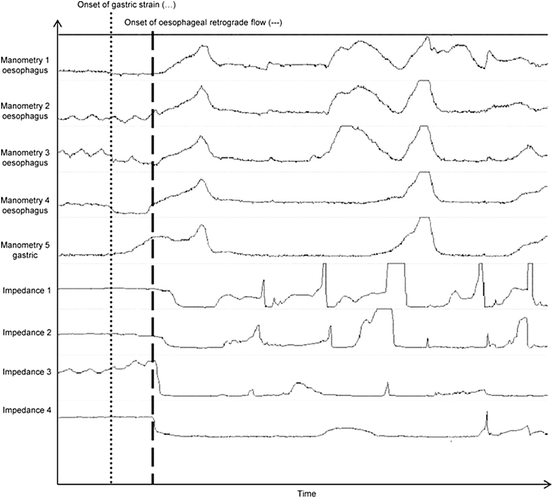Fig. 5.1
Impedance monitoring tracing during a supra-gastric belch demonstrates a pattern of rapid increase from the proximal to the distal esophagus followed by a retrograde decline
In addition to belching, patients with aerophagia often complain of bloating and abdominal discomfort. They often describe excessive flatulence and constipation as well. Indeed, these symptoms may predominate, and belching may be a secondary complaint. Physical examination may reveal abdominal tympani with normal bowel sounds. Abdominal radiographs in patients with aerophagia may demonstrate intestinal air without air–fluid levels. The Rome III criteria for aerophagia and excessive belching are shown in Table 5.1.
Table 5.1
Rome III diagnostic criteria for Aerophagia and unspecified excessive belchinga
Aerophagia (must include both of the following) | Unspecified excessive belching (must include both of the following) |
|---|---|
1. Troublesome repetitive belching at least several times a week 2. Air swallowing that is objectively observed or measured | 1. Troublesome repetitive belching at least several times a week 2. No evidence that excessive air swallowing underlies the symptom |
Similar to belching disorders, rumination can usually be diagnosed by clinical history without the need for diagnostic tests. Rumination may be difficult to distinguish from other functional disorders such as GERD and gastroparesis. The regurgitation associated with rumination typically occurs during or shortly following a meal. Regurgitation is effortless; it is not preceded by retching as is seen with emesis, and nausea is uncommon. These features differentiate rumination from gastroparesis. The regurgitated food typically is recognizable and has a pleasant taste. The process generally ceases once the food becomes acidic differentiating it from GERD. Nevertheless, rumination may be accompanied by heartburn secondary to the caustic effects of gastric contents in the esophagus. The disorder is frequently accompanied by weight loss, particularly in adolescents. It may be difficult to distinguish rumination from bulimia and/or anorexic behavior, and a high index of suspicion should be present in patients, particularly younger women, with other risk factors for these eating disorders. On examination, patients may be noted to have voluntary contraction of the abdominal musculature. The Rome III criteria for rumination syndrome are shown in Table 5.2. When the diagnosis remains uncertain, esophageal manometry with intraluminal impedance can distinguish rumination from other disorders. Rumination is characterized by a rise in manometric intragastric pressure, followed by retrograde esophageal flow as measured by impedance (see Fig. 5.2). Much less commonly performed, and much less widely available, antroduodenal manometry can also be used to diagnose rumination syndrome. During this procedure, the classic “R” wave indicative of rumination can be demonstrated. The R wave indicates a Valsalva maneuver, where intra-abdominal pressure increases, intrathoracic pressure increases, and esophageal pH drops. The differential diagnoses to be considered in belching, aerophagia, and rumination are given in Table 5.3.

Table 5.2
Rome III diagnostic criteria for rumination syndromea
Rumination syndrome (must include both of the following) |
|---|
1. Persistent or recurrent regurgitation of recently ingested food into the mouth with subsequent spitting or remastication and swallowing 2. Regurgitation is not preceded by retching |
Supportive criteria 1. Regurgitation events are usually not preceded by nausea 2. Cessation of the process when the regurgitated material becomes acidic 3. Regurgitant contains recognizable food with a pleasant taste |

Fig. 5.2
Combined manometry and impedance monitoring from a patient with rumination demonstrates a rise in intragastric pressure, followed by retrograde esophageal flow
Table 5.3
Differential diagnosis for aerophobia, excessive belching, and rumination
Aerophagia | Excessive belching | Rumination |
|---|---|---|
GERD Functional dyspepsia IBS Ileus Functional constipation < div class='tao-gold-member'>
Only gold members can continue reading. Log In or Register to continue
Stay updated, free articles. Join our Telegram channel
Full access? Get Clinical Tree
 Get Clinical Tree app for offline access
Get Clinical Tree app for offline access

|




